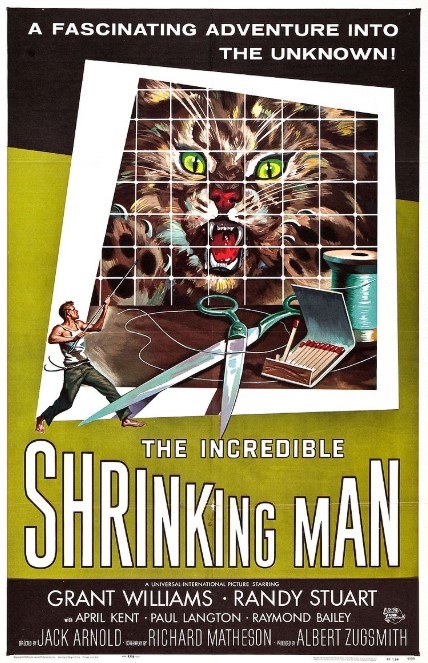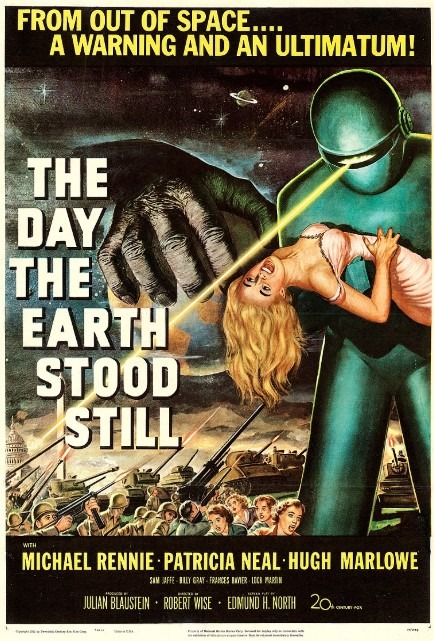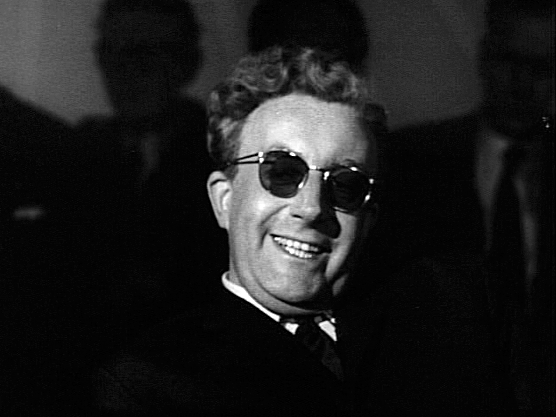The Atomic Age of Horror: Cold War Fears in 1960s Cinema

You'll find that 1960s horror cinema directly channeled Cold War anxieties through radiation-mutated monsters and mad scientists. The atomic bomb's impact altered traditional horror tropes, replacing supernatural threats with scientific terrors born from nuclear fears. Drive-in theaters became showcases for B-movies featuring everything from giant insects to body-snatching aliens. This marriage of horror and atomic age paranoia reveals deeper truths about America's Cold War psyche.
The Rise of Nuclear-Age Monsters
When the atomic bomb forever altered the global scene in 1945, it also reshaped the face of horror cinema.
You'll find that the Atomic Age ushered in a new generation of monsters that embodied society's deepest anxieties about nuclear technology. These weren't your traditional vampires or werewolves - they were creatures born from radiation and scientific hubris.
The most iconic example is Godzilla, emerging from the depths in 1954 as a direct response to atomic devastation. But you'll see this theme recurring throughout the era, as filmmakers modified Cold War fears into tangible threats on screen.
Mad scientists replaced traditional movie villains, representing the real-world creators of the atom bomb. These characters reflected growing public unease about unchecked scientific advancement and its potential for catastrophic consequences.
Films like Them! and Beast showcased humanity's arrogance through giant mutated creatures that emerged as direct consequences of nuclear testing.

Science Gone Wrong: Mad Scientists and Their Creations
Building on the atomic monster craze, Hollywood's portrayal of scientists took an even darker turn in the 1950s and 60s. You'll find that mad scientists became the new face of horror, reflecting Cold War anxieties about unchecked scientific advancement.
Films like The Fly and The Incredible Shrinking Man showed you what happens when laboratory experiments alter ordinary people into grotesque creatures. These weren't just monster movies - they were warnings about scientific hubris.
While Universal's classic monsters had supernatural origins, these new threats emerged directly from human ambition and technological overreach.
The scientists who created these horrors mirror the real-world weapons developers of the Cold War era. You're watching more than just fiction when characters like The Brain That Wouldn't Die's mad doctor play god - you're seeing society's deepest fears about science's destructive potential.
Much like The Day the Earth Stood Still, these films served as powerful allegories warning humanity about its self-destructive path toward atomic devastation.

Alien Invasions and Cold War Paranoia
Everyone feared the Red Menace during the 1950s, and Hollywood channeled those anxieties into a wave of alien invasion films. You'd find flying saucer stories reflecting America's deepest Cold War fears, from body-snatching aliens erasing individual identity to unstoppable cosmic threats from outer space.
The Blob's consuming mass represented the spread of communism across the globe. Films like Them! tapped into nuclear anxiety through giant mutant creatures. Invasion of the Body Snatchers played on fears of losing yourself to conformity.
While most films portrayed aliens as threats, The Day the Earth Stood Still offered a different outlook. Instead of invasion, you'd witness a peaceful visitor warning humanity about its destructive path. This reflected growing concerns about nuclear weapons and humanity's capacity for self-destruction during the Cold War era.
The tension escalated further when Sputnik 1's launch in 1957 sparked an intense technological race between the United States and Soviet Union.
Drive-In Culture and the B-Movie Explosion
As drive-in theaters flourished across America in the late 1950s, they created the perfect breeding ground for B-movie horror films. You'd find teenagers flocking to these outdoor venues, enthusiastic to catch the latest low-budget thrills from American International Pictures, who dominated the market with their quick-and-cheap production model.
While these drive-in horror movies weren't known for their stellar storytelling or production values, they struck a chord with young audiences seeking entertainment under the stars. Even Universal's classic monsters found new life during this era, as television broadcasts introduced them to fresh viewers.
The drive-in culture prioritized shock and spectacle over substance, leading to a boom in hastily produced features. You could say quantity trumped quality, but these B-movies left an enduring mark on horror cinema's evolution.
The Evolution of Horror Icons
Throughout the 1950s, horror cinema underwent a dramatic shift as atomic-age anxieties replaced traditional gothic fears. You'll notice how the classic Universal Monsters faded as new terrors emerged, reflecting society's growing unease with scientific advancement. Stars like Vincent Price and Christopher Lee brought fresh menace to the screen, while veterans Boris Karloff and Bela Lugosi saw their prominence diminish.
Mad scientists wielding dangerous technology replaced supernatural creatures. Radiation-mutated monsters embodied nuclear war anxieties. Alien invaders symbolized fears of foreign threats and infiltration.
The alteration wasn't just about different monsters - it represented a fundamental shift in what scared audiences. Science itself became the source of horror, with laboratories replacing castles and radiation taking the place of ancient curses. These changes marked horror's evolution from supernatural folklore to contemporary fears.

Societal Fears Reflected on Screen
Three distinct fears dominated the silver screen during the Cold War era: nuclear annihilation, scientific hubris, and foreign infiltration.
In the aftermath of World War II, you'll find these anxieties reflected in films that captured America's collective dread of atomic warfare.
The United States' rivalry with the Soviet Union spawned a new kind of horror cinema. You'll see this in films like "Godzilla" and "On the Beach," where filmmakers confronted audiences with stark visions of nuclear devastation.
The mad scientist character emerged as a terrifying new monster, embodying the public's growing distrust of unchecked scientific advancement.
While atomic narratives flourished through the 1980s, they began to fade as Cold War tensions eased in the 1990s. These films remain powerful testimonies to an era when the threat of nuclear annihilation shaped everyday life.
The Marriage of Horror and Science Fiction
Fear and fascination collided as horror and science fiction merged during the 1950s, creating a powerful new genre that spoke directly to atomic-age anxieties. You'll find this fusion perfectly captured in films like The Incredible Shrinking Man and The Astonishing Colossal Man, where radiation transforms ordinary people into scientific anomalies.
The marriage of these genres allowed filmmakers to investigate your deepest Cold War fears while cloaking them in fantastical narratives.
- Mad scientists wielding dangerous technology reflected your growing mistrust of unchecked scientific progress
- Radiation-mutated monsters like Godzilla symbolized the devastating power of nuclear weapons
- Body-snatching aliens represented the fear of losing your identity to invasive foreign influences
This powerful combination created a cinematic language that helped audiences process their anxieties about living in the shadow of the atom bomb.

Nuclear Apocalypse in Popular Cinema
As Cold War tensions reached their zenith, Hollywood responded with a wave of nuclear apocalypse films that forced audiences to confront their darkest fears about atomic warfare. You'll find this era's anxieties perfectly captured in movies like "On the Beach" and "Dr. Strangelove," which investigated humanity's potential extinction through nuclear annihilation.
Japan's "Godzilla" took a unique approach, using a destructive monster as a powerful metaphor for atomic devastation. Meanwhile, films like "Fail-Safe" and "The Bedford Incident" showed you just how easily human error or miscalculation could trigger a catastrophic nuclear exchange.
The Impact of 3D Technology on Horror Films
Despite its early reputation as a gimmick, 3D technology revolutionized horror cinema during the 1950s and 1960s by adding a new dimension of terror to the genre. You'll find that movies like House of Wax set the standard for immersive horror, with audiences jumping out of their seats as objects seemed to fly directly at them.
The three and a half year period between 1953 and 1956 marked the golden age of 3D horror films.
- Blood appeared to drip from the screen onto viewers' laps
- Axes and knives seemed to slash through the theater space
- Monster claws reached out to grasp unsuspecting audience members
These innovative effects converted passive moviegoers into active participants in the horror experience, forever changing how audiences engaged with scary movies.
Global Perspectives on Atomic Age Terror
While American audiences recoiled from 3D horror effects, viewers worldwide grappled with a far more terrifying reality: the destructive power of nuclear weapons. You'll find that international filmmakers investigated nuclear fears through distinct cultural lenses, creating powerful narratives that transcended borders.
Japan's "Godzilla" emerged just two years after Peter Cushing starred in his first horror film, offering a haunting metaphor for atomic devastation. Meanwhile, British productions like "On the Beach" scrutinized the human cost of nuclear war through a more somber lens.
These global viewpoints didn't just mirror Cold War anxieties - they delved deeper into the moral implications of nuclear technology. While Hollywood often focused on spectacular destruction, international cinema examined the psychological and societal trauma of living under the atomic shadow.




